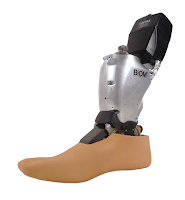The company was founded in 2006 by Hugh Herr, the head of Biomechatronics research group at the MIT Media Lab. Dr. Herr had to get both of his leg's amputated below the knees after a suffering severe frostbite caused by a rock climbing trip in New Hampshire. About 50 people work for BionX in Massachusetts. The commercial release date for the prosthesis, which is made of carbon fiber material, was early 2011 and 1,000 ankles have been sold and distributed since then. The device costs roughly $45,000.
Now, let's talk about what role the body plays in all this. The human ankle acts as a spring by exerting and releasing energy and force into the foot. The goal of the prosthesis is to generate the same amount of ankle torque that is given off by a human ankle during the gait cycle. The gait cycle is the sequence of events that occur during normal walking. The BiOM system focuses on Biometric Propulsion which consists of two parts: stiffness modulation and net-positive power assist. Stiffness modulation is resistance to foot flat and net-positive power assist is power assist with toe or heel off. There is a picture explaining the different stages of the gait cycle to make this easier to understand. The BiOM replaces the human tendon and muscle unit. The BiOM prosthetic runs on a battery. In a day an average person can go through 1-3 batteries depending on how active the person is. This particular prosthetic reduces wear and tear of the hip and knee muscles and joints that would normally experiences a lot of force with a passive ankle. Passive ankles are ankle prostheses that aren't operated with a motor. Typically, a person with a lower-limb amputation and a passive ankle would have to get knee and/or hip replacement surgery 5-7 years after receiving the passive ankle. Using the BiOM, persons with lower-limb amputations would need surgery about 10-15 years after receiving the Bionic ankle prostheses. The BiOM uses a high-energy series elastic actuator which allows to the motor to give off more power by pre-charging the spring in the ankle to provide the proper energy required to make walking seem as natural as possible. It also uses 6 Degrees of Freedom Inertial Sensing to provide for real time terrain discrimination.
 |
| The Gait Cycle |
Dr. Hugh Herr's TED Talk on the BiOM:
https://www.ted.com/talks/hugh_herr_the_new_bionics_that_let_us_run_climb_and_dance
Until next time,
Krishna Patel
